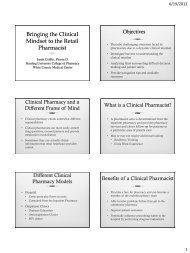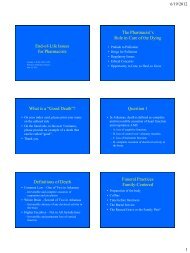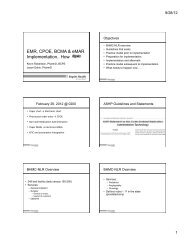Extended Infusion Piperacillin-Tazobactam Introduction & Background
Extended Infusion Piperacillin-Tazobactam Introduction & Background
Extended Infusion Piperacillin-Tazobactam Introduction & Background
You also want an ePaper? Increase the reach of your titles
YUMPU automatically turns print PDFs into web optimized ePapers that Google loves.
AAHP Fall Seminar — October 4-5, 2012<br />
Optimal Dosing of <strong>Piperacillin</strong>-<strong>Tazobactam</strong> for Treatment of<br />
Pseudomonas aeruginosa Infections: Prolonged or Continuous <strong>Infusion</strong>?<br />
Conclusions<br />
31<br />
Both prolonged- and continuous-infusion strategies<br />
improved PDs over traditional 30-minute intermittentinfusion<br />
regimens<br />
Prolonged- and continuous infusion regimens containing<br />
same daily doses had similar likelihoods of bactericidal<br />
exposure<br />
Kim et al. Pharmacotherapy 2007;27(11):1490–1497<br />
<strong>Piperacillin</strong>-<strong>Tazobactam</strong> for Pseudomonas aeruginosa Infection:<br />
Clinical Implications of an <strong>Extended</strong>-<strong>Infusion</strong> Dosing Strategy<br />
Purpose<br />
32<br />
Explore ways to optimize PDs of first-line antipseudomonal<br />
β-lactams to improve outcomes (patient survival, duration<br />
of hospitalization) associated with P. aeruginosa infection<br />
Design<br />
Population PK modeling & PD Monte Carlo simulation<br />
comparing dosing schemes to assess probability of<br />
achieving 50% fT>MIC vs P. aeruginosa.<br />
3.375 g as a 30-minute infusion q6hr<br />
3.375 g as a 30-minute infusion q4hr<br />
3.375 g as a 4-hour infusion q8hr<br />
Clin Infect Dis 2007;44:357-363.<br />
Pharmacotherapy 2006;26(9):1320-1332.<br />
Potential Ways of Maximizing T>MIC<br />
Higher dose<br />
Increase dosing frequency<br />
Increase duration of infusion (prolonged)<br />
Increased duration of infusion (continuous)<br />
33<br />
Adapted from: Lodise TP. Module: Applied Antimicrobial Pharmacodynamics. Society of<br />
Infectious Disease Pharmacists Antimicrobial Stewardship Certification Program 2010.<br />
Concentration (mg/L)<br />
Evaluation of T>MIC for Three Different Dosing<br />
Regimens for <strong>Piperacillin</strong><br />
1000<br />
100<br />
10<br />
1<br />
2 Gm as a 30-min infusion<br />
4 Gm as a 30-min infusion<br />
2 Gm as a 4-hr infusion<br />
MIC = 10 mg/L<br />
0 1 2 3 4 5 6 7 8<br />
Time (hour)<br />
Pharmacotherapy 2006;26(9):1320-1332.<br />
Probability of Target Attainment<br />
1.00<br />
0.80<br />
0.60<br />
0.40<br />
0.20<br />
<strong>Piperacillin</strong>-<strong>Tazobactam</strong><br />
Probability of 50% fT>MIC (free drug)<br />
3.375 Gm q6h<br />
0.5-hr infusion<br />
3.375 Gm q4h<br />
0.5-hr infusion<br />
3.375 Gm q8h<br />
4-hr infusion<br />
0.00<br />
0.25 0.5 1.0 2.0 4.0 8.0 16.0 32.0<br />
MIC (mg/L)<br />
Adapted from: Lodise et al. Clin Infect Dis 2007; 44:357–63; and Pharmacotherapy 2006;26:1320-1332<br />
Intermittent vs. Prolonged <strong>Infusion</strong>s of<br />
<strong>Piperacillin</strong>-<strong>Tazobactam</strong><br />
36<br />
Ann Pharmacother. 2009; 43:1747-1754.<br />
Scott E. Kaufman, RN, MA, Pharm.D. 6








